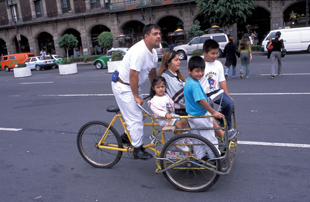Arequipa, Peru

The city of Arequipa, Peru has been reorganizing its transport system to include a new 23-kilometre Bus Rapid Transit (BRT) corridor running through the city centre. This includes modernized fleet and feeder lines, and bicycle and walking infrastructure. The project’s goals include: reducing greenhouse gas emissions from transport sources, enlivening public spaces and creating a vibrant transit system, alleviating the cost of travel and increasing economic competitiveness. Another stated goal of the initiative is reducing traffic-generated air pollution, traffic injuries and barriers to healthy physical activity.
Aguascalientes, Mexico

Mexico is facing two major transport-related health issues: high prevalence of deaths due to traffic injury and increasing levels of obesity.
In Mexico, traffic accidents are the leading cause of death of those aged 5-29, claiming 24 000 deaths and causing 700 000 injuries a year. Mexico’s overweight/obese population is one of the highest in the world at 68-70%, partly due to a lack of physical activity. The current sprawling pattern of urban expansion in Mexico exacerbates these issues, while having a negative effect on low-income groups.
A new project in this city of central Mexico aims to make new urban developments more liveable, safer and healthier. Mexico’s biggest mortgage lender, in partnership with the city of Aguascalientes, has designed a healthy and sustainable new housing development for 40 000 low-income families.
The first phase of the project is set to more than double the use of public transport and increase the proportion of trips made by foot and bicycle. The project aims to shift the urban development paradigm in Mexico towards a transit-oriented design for healthy communities.
South Africa

South Africa, a country that traditionally emphasised a private vehicle model of transport, has initiated new investments and policies aimed at promoting a shift from private to public transport.
Key components of the shift include:
- Bus Rapid Transit (BRT) initiatives;
- implementation of a modern commuter Gautrain;
- improved non-motorized transport facilities;
- heightened safety regulations;
- improves organization of the country’s paratransit (minibus and taxi) system;
- collaboration with international agencies and civil society.
While the new systems have had a positive impact, there has been opposition from some groups, including paratransit operators and communities through which new transit routes were proposed. Other barriers include spatial dispersion of population centres, high levels of pedestrian injuries, and development financing issues.
Asia and the Western Pacific

Asia includes cities with some of the highest rates of traffic growth and air pollution. A new WHO co-sponsored initiative for Environmentally Sustainable and Healthy Urban Transport (ESHUT) in Asia and the Western Pacific promotes strategies to achieve co-benefits for transport and health. ESHUT aims to reduce greenhouse emissions, air and noise pollution, road traffic injuries and second-hand smoke. In addition, the project aims to increase opportunities for physical activity as well as health and social equity by ensuring safe and equal access to urban public transport.
Examples of ESHUT activities:
- bicycle-friendly cities;
- pedestrianization;
- BRT and mass rapid transit;
- increased station connectivity;
- transport demand management;
- safe and hygienic roads and public transport.
